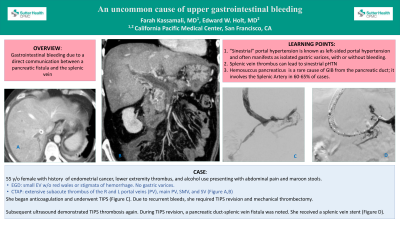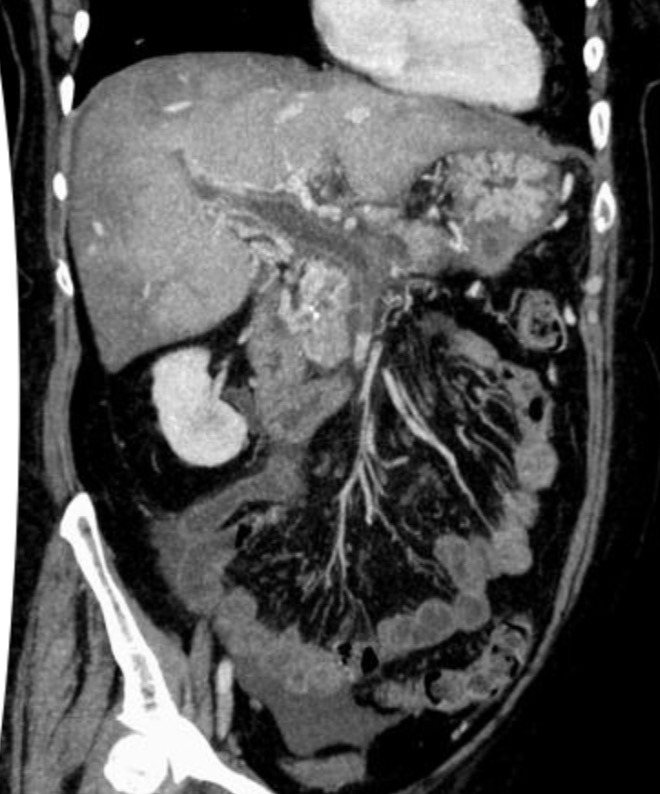Back


Poster Session B - Monday Morning
Category: GI Bleeding
B0325 - An Uncommon Cause of Upper Gastrointestinal Bleeding
Monday, October 24, 2022
10:00 AM – 12:00 PM ET
Location: Crown Ballroom

Has Audio
- FK
Farah Kassamali, MD
California Pacific Medical Center
San Francisco, CA
Presenting Author(s)
Farah Kassamali, MD, Edward Holt, MD
California Pacific Medical Center, San Francisco, CA
Introduction: We present a case of GI bleeding due to a direct communication between a pancreatic fistula and the splenic vein.
Case Description/Methods: A 55 year-old female with a history of endometrial cancer, superficial lower extremity thrombus, and alcohol use presented with abdominal pain and dark red blood in her stools requiring blood transfusion. She reported recent ibuprofen use.
An upper endoscopy showed small esophageal varices without red wales or stigmata of recent hemorrhage. A CT demonstrated extensive subacute thrombosis of the right and left portal veins, main portal vein (PV), proximal superior mesenteric vein (SMV) and splenic vein (SV). The pancreas appeared atrophic and contained small cysts. There was small ascites. Liver biopsy demonstrated mild steatohepatitis without fibrosis.
She underwent placement of a transjugular intrahepatic portosystemic shunt (TIPS) with thrombectomy from the PV, SMV, and SV and was started on anticoagulation. Due to bleeding recurrence, she underwent TIPS revision with tPA injection and additional mechanical thrombectomy.
Subsequently on an ultrasound, TIPS thrombosis was again noted and during TIPS revision, a communication was noted between the pancreatic duct and splenic vein, finally identifying the likely source of bleeding. A splenic vein stent was placed.
Discussion: This case highlights an uncommon cause of upper GI bleeding and reinforces the importance of keeping a broad differential diagnosis for a patient with portal hypertension. Our patient had a complicated course with 2 TIPS revisions and esophageal varices, but the source of her bleeding was neither variceal nor mucosal.
Splenic vein thrombus can result as a complication of pancreatitis and subsequently lead to “sinestrial” (left-sided) portal hypertension and the formation of gastric varices which can also present with gastrointestinal bleed (GIB).
Our patient did not have the classic finding of sinestral portal hypertension associated with SV thrombosis: gastric varices. Furthermore, during her initial TIPS placement and even her initial thrombectomy, no pancreatic fistula was observed. Although not always visualized due to the intermittent nature of bleeding, hemosuccus pancreaticus in the setting of chronic alcoholic pancreatitis most commonly involves the splenic artery (60-65%) and less commonly involves the gastroduodenal artery. Our patient’s case is unusual because angiogram demonstrated direct communication between a pancreatic fistula and the splenic vein, not the splenic artery.

Disclosures:
Farah Kassamali, MD, Edward Holt, MD. B0325 - An Uncommon Cause of Upper Gastrointestinal Bleeding, ACG 2022 Annual Scientific Meeting Abstracts. Charlotte, NC: American College of Gastroenterology.
California Pacific Medical Center, San Francisco, CA
Introduction: We present a case of GI bleeding due to a direct communication between a pancreatic fistula and the splenic vein.
Case Description/Methods: A 55 year-old female with a history of endometrial cancer, superficial lower extremity thrombus, and alcohol use presented with abdominal pain and dark red blood in her stools requiring blood transfusion. She reported recent ibuprofen use.
An upper endoscopy showed small esophageal varices without red wales or stigmata of recent hemorrhage. A CT demonstrated extensive subacute thrombosis of the right and left portal veins, main portal vein (PV), proximal superior mesenteric vein (SMV) and splenic vein (SV). The pancreas appeared atrophic and contained small cysts. There was small ascites. Liver biopsy demonstrated mild steatohepatitis without fibrosis.
She underwent placement of a transjugular intrahepatic portosystemic shunt (TIPS) with thrombectomy from the PV, SMV, and SV and was started on anticoagulation. Due to bleeding recurrence, she underwent TIPS revision with tPA injection and additional mechanical thrombectomy.
Subsequently on an ultrasound, TIPS thrombosis was again noted and during TIPS revision, a communication was noted between the pancreatic duct and splenic vein, finally identifying the likely source of bleeding. A splenic vein stent was placed.
Discussion: This case highlights an uncommon cause of upper GI bleeding and reinforces the importance of keeping a broad differential diagnosis for a patient with portal hypertension. Our patient had a complicated course with 2 TIPS revisions and esophageal varices, but the source of her bleeding was neither variceal nor mucosal.
Splenic vein thrombus can result as a complication of pancreatitis and subsequently lead to “sinestrial” (left-sided) portal hypertension and the formation of gastric varices which can also present with gastrointestinal bleed (GIB).
Our patient did not have the classic finding of sinestral portal hypertension associated with SV thrombosis: gastric varices. Furthermore, during her initial TIPS placement and even her initial thrombectomy, no pancreatic fistula was observed. Although not always visualized due to the intermittent nature of bleeding, hemosuccus pancreaticus in the setting of chronic alcoholic pancreatitis most commonly involves the splenic artery (60-65%) and less commonly involves the gastroduodenal artery. Our patient’s case is unusual because angiogram demonstrated direct communication between a pancreatic fistula and the splenic vein, not the splenic artery.

Figure: Large clot burden at superior mesenteric vein
Disclosures:
Farah Kassamali indicated no relevant financial relationships.
Edward Holt indicated no relevant financial relationships.
Farah Kassamali, MD, Edward Holt, MD. B0325 - An Uncommon Cause of Upper Gastrointestinal Bleeding, ACG 2022 Annual Scientific Meeting Abstracts. Charlotte, NC: American College of Gastroenterology.
